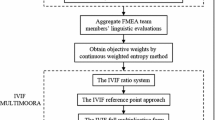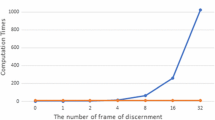Abstract
The failure mode and effect analysis (FMEA) is a prospective engineering technique which can prevent risk in advance by identifying, assessing potential failure modes and their effects. However, the traditional FMEA approach possesses the limitations in improperly identifying risk factor weights, inefficiently calculating risk priority number and improperly evaluating failure modes in practice. This paper proposes a hybrid risk analysis framework for FMEA based on interval type-2 fuzzy numbers and ORESTE method. First, the interval type-2 fuzzy numbers are utilized to express the uncertain risk evaluation information provided by experts. Second, the power average (PA) operator for interval type-2 fuzzy numbers is constructed to fuse individual risk assessment information and build the group risk assessment matrix. Then, the extended ORESTE method is introduced to determine the risk priority of each failure mode, in which distance measure of interval type-2 fuzzy numbers is incorporated. Finally, a case of ocean-going fishing vessel in a marine industry is selected to illustrate the application and feasibility of the proposed FMEA approach. A comparative analysis is performed to verify the effectiveness of the extended ORESTE method.


Similar content being viewed by others
References
Liu, H.C., Liu, L., Lin, Q.L.: Fuzzy failure mode and effects analysis using fuzzy evidential reasoning and belief rule-based Methodology. IEEE Trans. Reliab. 62(1), 23–36 (2013)
Kang, J.C., Sun, L.P., Sun, H., Wu, C.L.: Risk assessment of floating offshore wind turbine based on correlation-FMEA. Ocean Eng. 129, 382–388 (2017)
Kim, J.H., Jeong, H.Y., Park, J.S.: Development of the FMECA process and analysis methodology for railroad system. Int. J. Automot. Technol. 10(6), 753–759 (2009)
Chai, K.C., Jong, C.H., Tay, K.M., Lim, C.P.: A perceptual computing-based method to prioritize failure modes in failure mode and effect analysis and its application to edible bird nest farming. Appl. Soft Comput. 49, 734–747 (2016)
Chang, K.H., Cheng, C.H.: A risk assessment methodology using intuitionistic fuzzy set in FMEA. Int. J. Syst. Sci. 41(12), 1457–1471 (2010)
Wang, W., Liu, X., Liu, S.: Failure mode and effect analysis for machine tool risk analysis using extended gained and lost dominance score method. IEEE Trans. Reliab. (2019). https://doi.org/10.1109/TR.2019.2955500
Nie, R.X., Tian, Z.P., Wang, X.K., Wang, J.Q., Wang, T.L.: Risk evaluation by FMEA of supercritical water gasification system using multi-granular linguistic distribution assessment. Knowl. Based Syst. 162, 185–201 (2018)
Kutlu, A.C., Ekmekcioglu, M.: Fuzzy failure modes and effects analysis by using fuzzy TOPSIS-based fuzzy AHP. Expert Syst. Appl. 39(1), 61–67 (2012)
Zammori, F., Gabbrielli, R.: ANP/RPN: a multi criteria evaluation of the Risk Priority Number. Qual. Reliabil. Eng. Int. 28(1), 85–104 (2012)
Tooranloo, H.S., Ayatollah, A.S.: A model for failure mode and effects analysis based on intuitionistic fuzzy approach. Appl. Soft Comput. 49, 238–247 (2016)
Yazdi, M., Daneshvar, S., Setareh, H.: An extension to Fuzzy developed failure mode and effects analysis (FDFMEA) application for aircraft landing system. Saf. Sci. 98, 113–123 (2017)
Bozdag, E., Asan, U., Soyer, A., Serdarasan, S.: Risk prioritization in Failure Mode and Effects Analysis using interval type-2 fuzzy sets. Expert Syst. Appl. 42(8), 4000–4015 (2015)
Sharma, R., Sharma, P.: System failure behavior and maintenance decision making using, RCA, FMEA and FM. J. Qual. Maint. Eng. 16, 64–88 (2010)
Liu, H.C., Wang, L.E., You, X.Y., Wu, S.M.: Failure mode and effect analysis with extended grey relational analysis method in cloud setting. Total Qual. Manage. Bus. Excell. 30(7–8), 745–767 (2019)
Wang, W.Z., Liu, X.W., Qin, J.D., Liu, S.L.: An extended generalized TODIM for risk evaluation and prioritization of failure modes considering risk indicators interaction. Iise Trans. 51(11), 1236–1250 (2019)
Wang, W.Z., Liu, X.W., Qin, Y., Fu, Y.: A risk evaluation and prioritization method for FMEA with prospect theory and Choquet integral. Saf. Sci. 110, 152–163 (2018)
Wang, L.E., Liu, H.C., Quan, M.Y.: Evaluating the risk of failure modes with a hybrid MCDM model under interval-valued intuitionistic fuzzy environments. Comput. Ind. Eng. 102, 175–185 (2016)
Liu, H.C., Hu, Y.P., Wang, J.J., Sun, M.H.: Failure mode and effects analysis using two-dimensional uncertain linguistic variables and alternative queuing method. IEEE Trans. Reliab. 68(2), 554–565 (2019)
Qin, J.D., Liu, X.W., Pedrycz, W.: An extended TODIM multi-criteria group decision making method for green supplier selection in interval type-2 fuzzy environment. Eur. J. Oper. Res. 258(2), 626–638 (2017)
Qin, J.: Interval type-2 fuzzy Hamy mean operators and their application in multiple criteria decision making. Granul. Comput. 2(4), 249–269 (2017)
Wang, W.Z., Liu, X.W., Qin, J.D.: Risk priorization for failure modes with extended MULTIMOORA method under interval type-2 fuzzy environment. J. Intell. Fuzzy Syst. 36(2), 1417–1429 (2019)
Zhao, H., You, J.X., Liu, H.C.: Failure mode and effect analysis using MULTIMOORA method with continuous weighted entropy under interval-valued intuitionistic fuzzy environment. Soft. Comput. 21(18), 5355–5367 (2017)
Liu, H.C., You, J.X., Ding, X.F., Su, Q.: Improving risk evaluation in FMEA with a hybrid multiple criteria decision making method. Int. J. Qual. Reliabil. Manage. 32(7), 763–765 (2015)
Liu, H.C., You, J.X., Chen, S.M., Chen, Y.Z.: An integrated failure mode and effect analysis approach for accurate risk assessment under uncertainty. IIE Trans. 48(11), 1027–1042 (2016)
Zhang, H.J., Zhou, Y., Gan, Q.H.: An extended PROMETHEE-II-based risk prioritization method for equipment failures in the geothermal power plant. Int. J. Fuzzy Syst. 21(8), 2490–2509 (2019)
Delice, E.K., Can, G.F.: A stochastic approach for failure mode and effect analysis. Rairo-Oper. Res. 51(4), 1077–1100 (2017)
Mohsen, O., Fereshteh, N.: An extended VIKOR method based on entropy measure for the failure modes risk assessment: a case study of the geothermal power plant (GPP). Saf. Sci. 92, 160–172 (2017)
Wang, Z.L., You, J.X., Liu, H.C., Wu, S.M.: Failure Mode and Effect Analysis using Soft Set Theory and COPRAS Method. Int. J. Comput. Intell. Syst. 10(1), 1002–1015 (2017)
Song, W.Y., Ming, X.G., Wu, Z.Y., Zhu, B.T.: Failure modes and effects analysis using integrated weight-based fuzzy TOPSIS. Int. J. Comput. Integr. Manuf. 26(12), 1172–1186 (2013)
Roubens, M.: Preference relations on actions and criteria in multicriteria decision-making. Eur. J. Oper. Res. 10(1), 51–55 (1982)
Pastijn, H., Leysen, J.: Constrcting an outranking relation with ORESTE. Math. Comput. Modell. 12(10–11), 1255–1268 (1989)
Liao, H.C., Wu, X.L., Liang, X.D., Xu, J.P., Herrera, F.: A new hesitant fuzzy linguistic ORESTE method for hybrid multicriteria decision making. IEEE Trans. Fuzzy Syst. 26(6), 3793–3807 (2018)
Li, J.L., Luo, L., Wu, X.L., Liao, C.C., Liao, H.C., Shen, W.W.: Prioritizing the elective surgery patient admission in a Chinese public tertiary hospital using the hesitant fuzzy linguistic ORESTE method. Appl. Soft Comput. 78, 407–419 (2019)
Wu, X.L., Liao, H.C.: An approach to quality function deployment based on probabilistic linguistic term sets and ORESTE method for multi-expert multi-criteria decision making. Inform. Fusion 43, 13–26 (2018)
Mendel, J.M., Rajati, M.R., Sussner, P.: On clarifying some definitions and notations used for type-2 fuzzy sets as well as some recommended changes. Inf. Sci. 340, 337–345 (2016)
Wu, D.R., Mendel, J.M.: Uncertainty measures for interval type-2 fuzzy sets. Inform. Sci. 177(23), 5378–5393 (2007)
Chen, S.-M., Wang, C.-Y.: Fuzzy decision making systems based on interval type-2 fuzzy sets. Inform. Sci. 242, 1–21 (2013)
Yager, R.: The power average operator. IEEE Trans. Syst. Man Cybernet. Part A 31, 724–731 (2001)
Son, M.J., Park, J.H., Ko, K.H.: Some hesitant fuzzy hamacher power-aggregation operators for multiple-attribute decision-making. Mathematics 7(7), 24–50 (2019)
Abdel-Basset, M., Saleh, M., Gamal, A., Smarandache, F.: An approach of TOPSIS technique for developing supplier selection with group decision making under type-2 neutrosophic number. Appl. Soft Comput. 77, 438–452 (2019)
Abdullah, L., Najib, L.: A new type-2 fuzzy set of linguistic variables for the fuzzy analytic hierarchy process. Expert Syst. Appl. 41(7), 3297–3305 (2014)
Pillay, A., Wang, J.: Modified failure mode and effects analysis using approximate reasoning. Reliabil. Eng. Syst. Saf. 79(1), 69–85 (2003)
Acknowledgements
This work was supported by the National Science Foundation of China (NSFC) (72071045, 71771051, and 71871121), MOE (Ministry of Education in China) Project of Humanities and Social Sciences (19YJC630160).
Author information
Authors and Affiliations
Corresponding authors
Appendices
Appendix A: Proof of Theorem 1
Proof
Equation (6) can be proved by mathematical induction on k as follows.
-
(1)
For k = 1, the result of Eq. (6) is obviously.
-
(2)
Assume that Eq. (6) holds for k = q that is
$$ PA - IT2TrFNs(a_{1} ,a_{2} , \ldots ,a_{q} ) = \left[ {\begin{array}{*{20}c} {\left( {\frac{{\sum\nolimits_{k = 1}^{q} {(1 + T(a_{k} ))a_{k1}^{L} } }}{{\sum\nolimits_{k = 1}^{q} {(1 + T(a_{k} ))} }},\frac{{\sum\nolimits_{k = 1}^{q} {(1 + T(a_{k} ))a_{k2}^{L} } }}{{\sum\nolimits_{k = 1}^{q} {(1 + T(a_{k} ))} }},} \right.} \\ {\left. {\frac{{\sum\nolimits_{k = 1}^{q} {(1 + T(a_{k} ))a_{k3}^{L} } }}{{\sum\nolimits_{k = 1}^{q} {(1 + T(a_{k} ))} }},\frac{{\sum\nolimits_{k = 1}^{q} {(1 + T(a_{k} ))a_{k4}^{L} } }}{{\sum\nolimits_{k = 1}^{q} {(1 + T(a_{k} ))} }};\mathop {\hbox{min} }\limits_{k = 1,2, \ldots ,q} h_{k}^{L} } \right),} \\ {\left( {\frac{{\sum\nolimits_{k = 1}^{q} {(1 + T(a_{k} ))a_{k1}^{U} } }}{{\sum\nolimits_{k = 1}^{q} {(1 + T(a_{k} ))} }},\frac{{\sum\nolimits_{k = 1}^{q} {(1 + T(a_{k} ))a_{k2}^{U} } }}{{\sum\nolimits_{k = 1}^{q} {(1 + T(a_{k} ))} }},} \right.} \\ {\left. {\frac{{\sum\nolimits_{k = 1}^{q} {(1 + T(a_{k} ))a_{k3}^{U} } }}{{\sum\nolimits_{k = 1}^{q} {(1 + T(a_{k} ))} }},\frac{{\sum\nolimits_{k = 1}^{q} {(1 + T(a_{k} ))a_{k4}^{U} } }}{{\sum\nolimits_{k = 1}^{q} {(1 + T(a_{k} ))} }};\mathop {\hbox{min} }\limits_{k = 1,2, \ldots ,q} h_{k}^{U} } \right)} \\ \end{array} } \right]. $$ -
(3)
Then, when \( k = q{ + }1 \), by the algorithms of IT2TrFN in Definition 2, we have
$$ \begin{aligned} PA - & IT2TrFNs(a_{1} ,a_{2} , \ldots ,a_{q} ,a_{q + 1} ) \\ & = \left[ {\begin{array}{*{20}c} {\left( {\frac{{\sum\nolimits_{k = 1}^{q} {(1 + T(a_{k} ))a_{k1}^{L} } }}{{\sum\nolimits_{k = 1}^{q + 1} {(1 + T(a_{k} ))} }},\frac{{\sum\nolimits_{k = 1}^{q} {(1 + T(a_{k} ))a_{k2}^{L} } }}{{\sum\nolimits_{k = 1}^{q + 1} {(1 + T(a_{k} ))} }},} \right.} \\ {\left. {\frac{{\sum\nolimits_{k = 1}^{q} {(1 + T(a_{k} ))a_{k3}^{L} } }}{{\sum\nolimits_{k = 1}^{q + 1} {(1 + T(a_{k} ))} }},\frac{{\sum\nolimits_{k = 1}^{q} {(1 + T(a_{k} ))a_{k4}^{L} } }}{{\sum\nolimits_{k = 1}^{q + 1} {(1 + T(a_{k} ))} }};\mathop {\hbox{min} }\limits_{k = 1,2, \ldots ,q} h_{k}^{L} ),} \right)} \\ {\left( {\frac{{\sum\nolimits_{k = 1}^{q} {(1 + T(a_{k} ))a_{k1}^{U} } }}{{\sum\nolimits_{k = 1}^{q + 1} {(1 + T(a_{k} ))} }},\frac{{\sum\nolimits_{k = 1}^{q} {(1 + T(a_{k} ))a_{k2}^{U} } }}{{\sum\nolimits_{k = 1}^{q + 1} {(1 + T(a_{k} ))} }},} \right.} \\ {\left. {\frac{{\sum\nolimits_{k = 1}^{q} {(1 + T(a_{k} ))a_{k3}^{U} } }}{{\sum\nolimits_{k = 1}^{q + 1} {(1 + T(a_{k} ))} }},\frac{{\sum\nolimits_{k = 1}^{q} {(1 + T(a_{k} ))a_{k4}^{U} } }}{{\sum\nolimits_{k = 1}^{q + 1} {(1 + T(a_{k} ))} }};\mathop {\hbox{min} }\limits_{k = 1,2, \ldots ,q} h_{k}^{U} } \right)} \\ \end{array} } \right] \\ & \; + \left[ {\begin{array}{*{20}c} {\left( {\frac{{(1 + T(a_{q + 1} ))a_{(q + 1)1}^{L} }}{{\sum\nolimits_{k = 1}^{q + 1} {(1 + T(a_{ij}^{k} ))} }},\frac{{(1 + T(a_{q + 1} ))a_{(q + 1)2}^{L} }}{{\sum\nolimits_{k = 1}^{q + 1} {(1 + T(a_{ij}^{k} ))} }},} \right.} \\ {\left. {\frac{{(1 + T(a_{q + 1} ))a_{(q + 1)3}^{L} }}{{\sum\nolimits_{k = 1}^{q + 1} {(1 + T(a_{ij}^{k} ))} }},\frac{{(1 + T(a_{q + 1} ))a_{(q + 1)4}^{L} }}{{\sum\nolimits_{k = 1}^{q + 1} {(1 + T(a_{ij}^{k} ))} }};h_{(q + 1)}^{L} ),} \right)} \\ {\left( {\frac{{(1 + T(a_{q + 1} ))a_{(q + 1)1}^{U} }}{{\sum\nolimits_{k = 1}^{q + 1} {(1 + T(a_{k} ))} }},\frac{{(1 + T(a_{q + 1} ))a_{(q + 1)2}^{U} }}{{\sum\nolimits_{k = 1}^{q + 1} {(1 + T(a_{k} ))} }},} \right.} \\ {\left. {\frac{{(1 + T(a_{q + 1} ))a_{(q + 1)3}^{U} }}{{\sum\nolimits_{k = 1}^{q + 1} {(1 + T(a_{k} ))} }},\frac{{(1 + T(a_{q + 1} ))a_{(q + 1)4}^{U} }}{{\sum\nolimits_{k = 1}^{q + 1} {(1 + T(a_{k} ))} }};h_{(q + 1)}^{U} } \right)} \\ \end{array} } \right] \\ & = \left[ {\begin{array}{*{20}c} {\left( {\frac{{\sum\nolimits_{k = 1}^{q + 1} {(1 + T(a_{k} ))a_{k1}^{L} } }}{{\sum\nolimits_{k = 1}^{q + 1} {(1 + T(a_{k} ))} }},\frac{{\sum\nolimits_{k = 1}^{q + 1} {(1 + T(a_{k} ))a_{k2}^{L} } }}{{\sum\nolimits_{k = 1}^{q + 1} {(1 + T(a_{k} ))} }},} \right.} \\ {\left. {\frac{{\sum\nolimits_{k = 1}^{q + 1} {(1 + T(a_{k} ))a_{k3}^{L} } }}{{\sum\nolimits_{k = 1}^{q + 1} {(1 + T(a_{k} ))} }},\frac{{\sum\nolimits_{k = 1}^{q + 1} {(1 + T(a_{k} ))a_{k4}^{L} } }}{{\sum\nolimits_{k = 1}^{q + 1} {(1 + T(a_{k} ))} }};\mathop {\hbox{min} }\limits_{k = 1,2, \ldots ,q + 1} h_{k}^{L} ),} \right)} \\ {\left( {\frac{{\sum\nolimits_{k = 1}^{q + 1} {(1 + T(a_{k} ))a_{k1}^{U} } }}{{\sum\nolimits_{k = 1}^{q + 1} {(1 + T(a_{k} ))} }},\frac{{\sum\nolimits_{k = 1}^{q + 1} {(1 + T(a_{k} ))a_{k2}^{U} } }}{{\sum\nolimits_{k = 1}^{q + 1} {(1 + T(a_{k} ))} }},} \right.} \\ {\left. {\frac{{\sum\nolimits_{k = 1}^{q + 1} {(1 + T(a_{k} ))a_{k3}^{U} } }}{{\sum\nolimits_{k = 1}^{q + 1} {(1 + T(a_{k} ))} }},\frac{{\sum\nolimits_{k = 1}^{q + 1} {(1 + T(a_{k} ))a_{k4}^{U} } }}{{\sum\nolimits_{k = 1}^{q + 1} {(1 + T(a_{k} ))} }};\mathop {\hbox{min} }\limits_{k = 1,2, \ldots ,q + 1} h_{k}^{U} } \right)} \\ \end{array} } \right] \\ \end{aligned}. $$So, when \( k = q{ + }1 \), Eq. (16) is also right.
Consequently, according to mathematical induction given by (1) and (2), Eq. (21) holds for all k.
Appendix B: Proof of Theorem 1
Proof
-
(1)
As \( a_{k} = a_{0} (k = 1,2, \ldots ,q) \) , by the algorithms of IT2TrFN in Definition 5, we have
$$ \begin{aligned} PA - IT2TrFNs(a_{1} ,a_{2} , \ldots ,a_{q} ) = & IT2TrFN - PA(a_{0} ,a_{0} , \ldots ,a_{0} ) \\ & = \left[ {\begin{array}{*{20}c} {\left( {\frac{{\sum\nolimits_{k = 1}^{q} {(1 + T(a_{0} ))a_{01}^{L} } }}{{\sum\nolimits_{k = 1}^{q} {(1 + T(a_{0} ))} }},\frac{{\sum\nolimits_{k = 1}^{q} {(1 + T(a_{0} ))a_{02}^{L} } }}{{\sum\nolimits_{k = 1}^{q} {(1 + T(a_{0} ))} }},} \right.} \\ {\left. {\frac{{\sum\nolimits_{k = 1}^{q} {(1 + T(a_{0} ))a_{03}^{L} } }}{{\sum\nolimits_{k = 1}^{q} {(1 + T(a_{0} ))} }},\frac{{\sum\nolimits_{k = 1}^{q} {(1 + T(a_{0} ))a_{04}^{L} } }}{{\sum\nolimits_{k = 1}^{q} {(1 + T(a_{0} ))} }};\mathop {\hbox{min} }\limits_{k = 1,2, \ldots ,q} h_{0}^{L} } \right),} \\ {\left( {\frac{{\sum\nolimits_{k = 1}^{q} {(1 + T(a_{0} ))a_{01}^{U} } }}{{\sum\nolimits_{k = 1}^{q} {(1 + T(a_{0} ))} }},\frac{{\sum\nolimits_{k = 1}^{q} {(1 + T(a_{0} ))a_{02}^{U} } }}{{\sum\nolimits_{k = 1}^{q} {(1 + T(a_{0} ))} }},} \right.} \\ {\left. {\frac{{\sum\nolimits_{k = 1}^{q} {(1 + T(a_{0} ))a_{03}^{U} } }}{{\sum\nolimits_{k = 1}^{q} {(1 + T(a_{0} ))} }},\frac{{\sum\nolimits_{k = 1}^{q} {(1 + T(a_{0} ))a_{04}^{U} } }}{{\sum\nolimits_{k = 1}^{q} {(1 + T(a_{0} ))} }};\mathop {\hbox{min} }\limits_{k = 1,2, \ldots ,q} h_{0}^{U} } \right)} \\ \end{array} } \right] \\ \end{aligned}. $$Since \( a_{k} = a_{0} \) for all the k, then we can obtain \( T(a_{0} ) = 0 \). Consequently,\( \begin{aligned} PA - IT2TrFNs(a_{1} ,a_{2} , \ldots ,a_{q} ) = & PA - IT2TrFNs(a_{0} ,a_{0} , \ldots ,a_{0} ) \\ & = \left[ {\begin{array}{*{20}c} {\left( {a_{01}^{L} ,a_{02}^{L} ,} \right.} \\ {\left. {a_{03}^{L} ,a_{04}^{L} ;h_{0}^{L} } \right),} \\ {\left( {a_{01}^{U} ,a_{02}^{U} ,} \right.} \\ {\left. {a_{03}^{U} ,a_{04}^{U} ;h_{0}^{U} } \right)} \\ \end{array} } \right] = a_{0} \\ \end{aligned} \)
-
(2)
Assume that \( c_{0} = a_{\hbox{max} } = \hbox{max} (a_{1} ,a_{2} , \ldots ,a_{q} ) \) and \( d_{0} = a_{\hbox{min} } = \hbox{min} (a_{1} ,a_{2} , \ldots ,a_{q} ) \), then we can have
$$ \begin{aligned} c_{0} = & PA - IT2TrFNs(c_{0} ,c_{0} , \ldots ,c_{0} ) \\ & \le PA - IT2TrFNs(a_{1} ,a_{2} , \ldots ,a_{q} ) \\ & \le PA - IT2TrFNs(d_{0} ,d_{0} , \ldots ,d_{0} ) \\ & = d_{0} \\ \end{aligned}. $$Therefore, we can get \( a_{\hbox{min} } \le PA - IT2TrFNs(a_{1} ,a_{2} , \ldots ,a_{q} ) \le a_{\hbox{max} }. \)
-
(3)
Since \( a_{i} \le b_{j} (i,j = 1,2, \ldots ,q) \) and PA operator is an Augment function, then
$$ IT2TrFN - PA(a_{1} ,a_{2} , \ldots ,a_{q} ) \le IT2TrFN - PA(b_{1} ,b_{2} , \ldots ,b_{q} ). $$
Rights and permissions
About this article
Cite this article
Zheng, Q., Liu, X. & Wang, W. An Extended Interval Type-2 Fuzzy ORESTE Method for Risk Analysis in FMEA. Int. J. Fuzzy Syst. 23, 1379–1395 (2021). https://doi.org/10.1007/s40815-020-01034-1
Received:
Revised:
Accepted:
Published:
Issue Date:
DOI: https://doi.org/10.1007/s40815-020-01034-1




